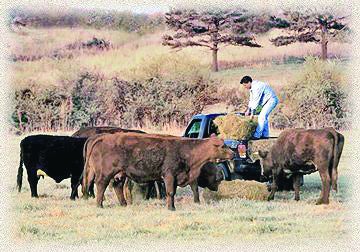Supplemental feeding advice from Texas
Published 2:18 pm Monday, May 23, 2011
If your pasture looks like mine, the lack of rainfall is beginning to take a severe toll on grazing.
But anyone who has been in the cattle businesses for any length of time knows that during a drought, providing supplementing feed is the first step in maintaining herd health.
Currently, Texas is under an extreme drought causing cattlemen to begin liquidating their herds. To assist cattlemen during this hardship, Texas A&M extension livestock specialist have provided some practical advice on supplemental feeding.
The basic “art” of supplemental feeding during a drought is knowing when to quit feeding, and start selling livestock when the animal’s nutrient requirements can no longer be economically met.
An economical feed supplement goes hand-in-hand with proper stocking rate, since the objective of any supplemental feed program is to augment a grass-based diet. A 1,000-pound cow requires 20 to 25 pounds of dry forage per day.
Higher density energy supplements may help make up for short grass, but remember that cereal grains must be fed every day to keep acidosis problems in check, and also to reduce the negative effects that grain may have on the animal’s ability to digest pasture forage. Again, when forage is extremely short, supplementation of large quantities of energy in any form for extended periods of time is usually uneconomical.
Remember there are no magic bullets when evaluating supplements. Animals will perform so long as their supplement compensates for what nutrients are limiting in their diet. Protein is usually the first limiting nutrient in dormant forage. In fact, a dry cow requires a minimum of 7 percent crude protein in her diet just to keep the digestive system “bugs” alive and working on forage digestion.
Protein supplementation can actually stimulate forage intake. Nutrient content and price per pound of nutrient(s) in the supplement are the most important things to evaluate. For example, if the cost per pound of crude protein, of a 38 percent cube provides 760 pounds of crude protein per ton of bulk feed.
At $280 per ton, it costs 37 cents to provide a pound of protein. A 20 percent cube provides 400 pounds of actual protein per ton of bulk feed. At $210 per ton it costs 53 cents to provide a pound of crude protein. If protein were the only concern, then the 38 percent cube would be the better buy.
However, if grass is not only dormant, but also in short supply, then the 20 percent cube, fed at twice the rate, would probably be a more complete feed because it would provide some extra energy as well.
The form of supplement, be it block, cube, lick, meal, etc., is unimportant as long as consumption of limiting nutrients is adequate. If animal supplemental requirements are particularly high, some self-fed supplements may not allow for this to occur.
Molasses can be used to stretch short grass, but just like grain supplements, molasses will require that a high quality protein supplement accompany it. Molasses is handy because as an energy feed, it can be self-fed; eliminating the need for daily feeding.
Be cautious. Many molasses supplements will contain non-protein nitrogen (NPN) such as urea, for a “protein” source. NPN is not a drought supplement. It is used most effectively when grass is abundant but dormant, when dietary protein requirements are lowest (dry females), and when dietary protein needs to be increased only slightly.
When purchasing feed, you can forward contract and use bulk storage to save a few dollars. Late summer is typically when feed stuffs are cheapest. Reduce feeding frequency. Protein supplements may be fed as infrequently as twice, or even once per week. Use a good 1:1 calcium to phosphorus mineral. Inject vitamin A if it has been more than four months since there has been any green forage.
With today’s cattle prices, a pasture under severe drought probably could not be supplemented economically if feed cost more than $160 per ton. This assumes that a large percentage of the animal’s requirements would be met with supplement.
Knowing diet quality lets you know what type of supplementation will be necessary in order to meet the animal’s nutrient requirements. Livestock and feed prices will tell you if that answer is economically feasible.






